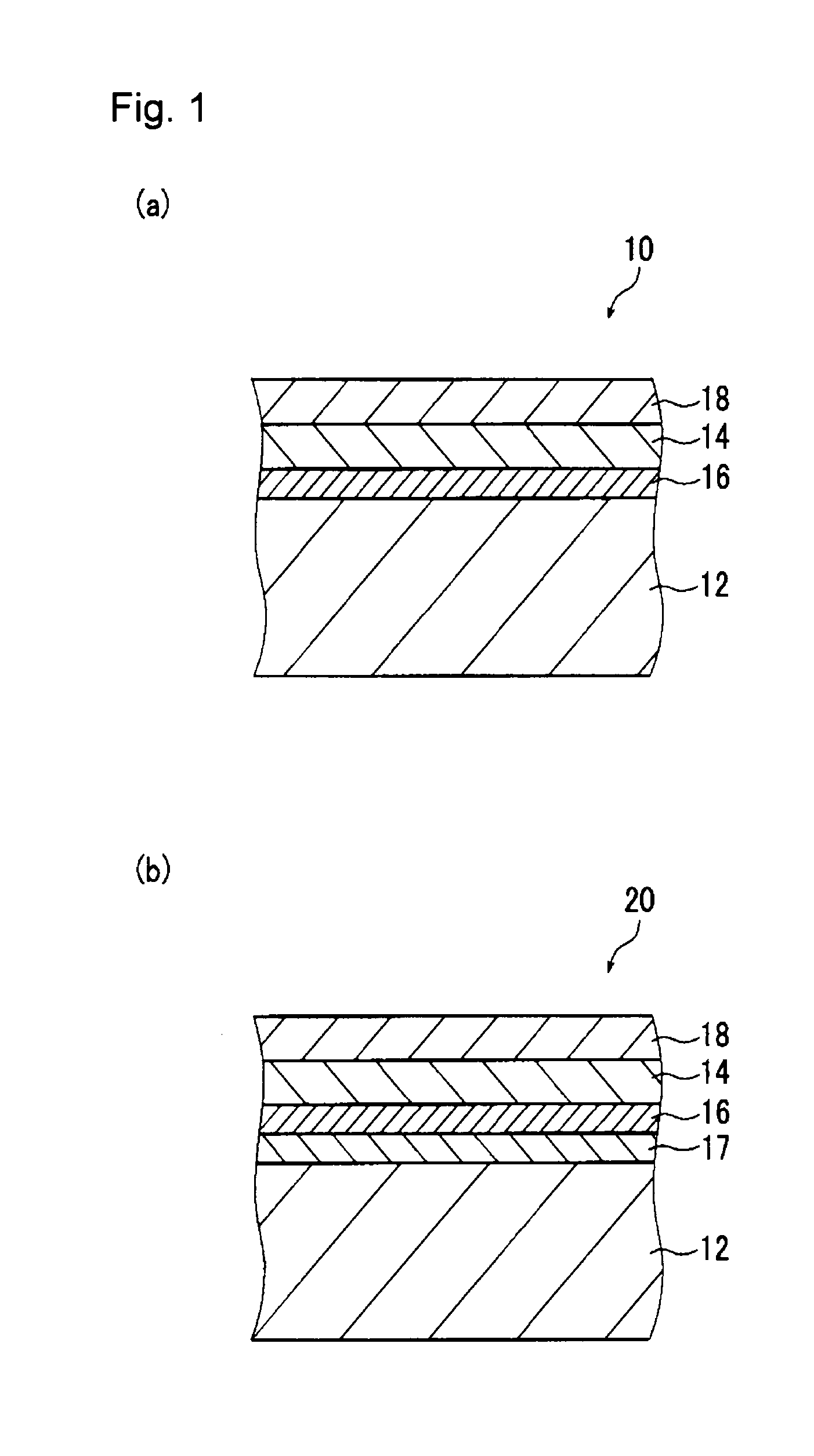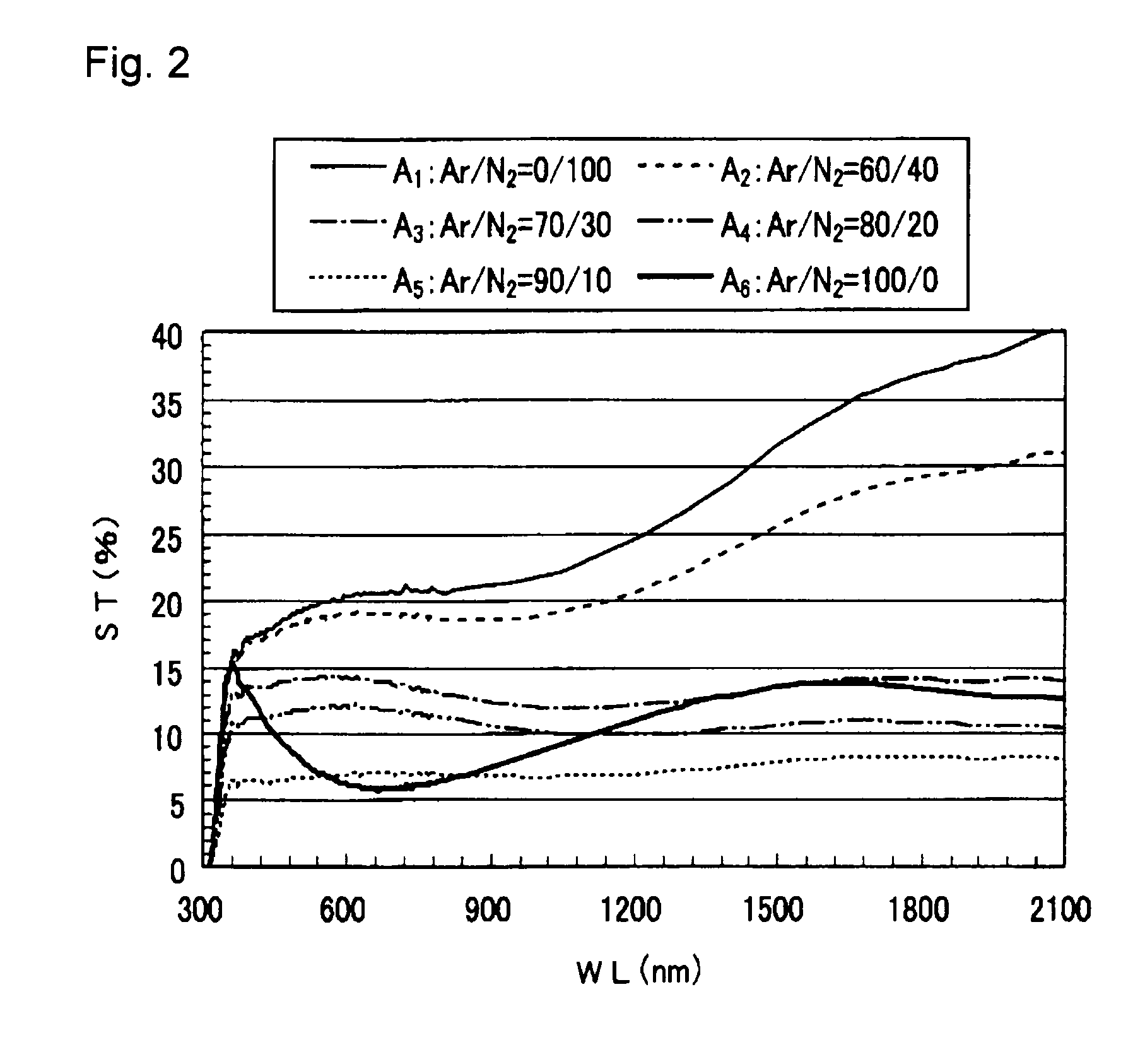Heat reflecting glass and process for producing heat reflecting glass
a technology of heat reflecting glass and heat reflecting glass, which is applied in the field of heat reflecting glass, can solve the problems of not meeting all the demands, the heat reflecting glass prepared by the process disclosed, etc., and achieve the effects of preventing heat from entering the room, preventing glare felt by a person, and preventing visible light transmittance tv
- Summary
- Abstract
- Description
- Claims
- Application Information
AI Technical Summary
Benefits of technology
Problems solved by technology
Method used
Image
Examples
example 1
[0060]As Example 1, a heat reflecting glass corresponding to the first embodiment shown in FIG. 1(a) was prepared. Specifically, in Example 1, an oxygen-blocking undercoat film made of silicon nitride (SiNx) was formed on a glass substrate (FL6) by reactive sputtering, and as laminated on the surface of the oxygen-blocking undercoat film, a chromium nitride film was formed by reactive sputtering. Further, as laminated on the surface of the chromium nitride film, an oxygen-blocking protective film made of silicon nitride was formed.
[0061]The conditions at the time of forming the oxygen-blocking undercoat film and the oxygen-blocking protective film made of silicon nitride (SiNx), were as follows.[0062]Sputtering target: Polycrystalline Si target having a size of 130 mm×430 mm[0063]N2 gas flow rate during sputtering: 100 sccm[0064]Pressure in the chamber during sputtering: 5.1×10−1 Pa[0065]Plasma-forming electric power: 2.00 kW as electric power supplied from a DC pulse power source
[0...
example 2
[0086]Firstly, the optical performance of a single chromium nitride (CrNx) film was examined as a Reference Example.
[0087]FIG. 2 is an example of results of tests carried out by the present inventors and shows spectra of spectral transmittances of a plurality of samples A1 to A5 constructed by preparing a single chromium nitride (CrNx) film on a glass substrate under respectively different film-deposition conditions. Each of the plurality of samples A1 to A5 is a sample obtained by preparing a chromium nitride film on the surface of a clean glass substrate (FL6) by a reactive sputtering method.
[0088]Each of chromium nitride (CrNx) single film samples A1 to A5 is a sample prepared in such a manner that a glass plate is disposed in a reactor (vacuum chamber) and sputtering is carried out by using a chromium (Cr) target as a sputtering target while the interior of the vacuum chamber is controlled to be a N2 gas-containing atmosphere, to form a chromium nitride film for heat reflection ...
example 3
[0113]Further, FIG. 6 shows the spectra of spectral transmittances of a plurality of samples D1 to D5 which were, respectively, formed by changing the film thickness of a chromium nitride film (CrNx) under a gas flow rate condition of (Ar:N2)=(80:20). Each of samples D1 to D5 is different only in the film thickness of each chromium nitride film (CrNx) from the film deposition conditions for sample C4. That is, each of samples D1 to D5 shown in FIG. 6 is prepared by setting the Ar gas flow rate / N2 gas flow rate to be (Ar:N2)═(80:20) and has a ratio in the number of atoms (N / Cr) in the chromium nitride film being 0.41. Further, the film thickness shown in the graph in FIG. 6 was obtained by a film deposition time preliminarily calculated from the measured value by using the preliminarily obtained film deposition rate.
[0114]As shown in FIG. 6, in a case where the ratio of nitrogen atoms to chromium atoms (N / Cr) in the chromium nitride film is substantially equal, even if the thickness ...
PUM
| Property | Measurement | Unit |
|---|---|---|
| visible light transmittance | aaaaa | aaaaa |
| temperature | aaaaa | aaaaa |
| thickness | aaaaa | aaaaa |
Abstract
Description
Claims
Application Information
 Login to View More
Login to View More - R&D
- Intellectual Property
- Life Sciences
- Materials
- Tech Scout
- Unparalleled Data Quality
- Higher Quality Content
- 60% Fewer Hallucinations
Browse by: Latest US Patents, China's latest patents, Technical Efficacy Thesaurus, Application Domain, Technology Topic, Popular Technical Reports.
© 2025 PatSnap. All rights reserved.Legal|Privacy policy|Modern Slavery Act Transparency Statement|Sitemap|About US| Contact US: help@patsnap.com



